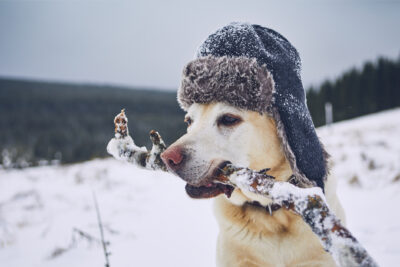How Can You Tell If Your Dog Is Sad?

As a pet parent, it can be difficult when you start to notice some changes in your dog’s behavior. If your dog is usually lively, energetic, or simply bursting with a specific personality, and you notice a shift, of course, you’re bound to be concerned.
Grief and depression are real for dogs, according to Wailani Sung, DVM, “There is evidence that dogs can experience depression, especially if there has been a stressful or traumatic change in their lives. However, some dogs may experience depression relating to the worsening of an anxiety disorder.”
HOW TO SPOT IT: The signs of depression in dogs
While the signs of depression in your dog are not usually an emergency situation, they are obvious and hard to ignore.
When your dog loses interest in everyday activities that normally excite them, depression could be the reason. That said, if you notice these changes in your dog it’s important to rule out other potential medical reasons that could be causing the same signs. Your veterinarian can assist with this.
Less interest in things that excite them
Dr. Sung suggests you look for signals like:
- If your dog is usually one to tap dance in excitement at the mere sight of his leash, but now needs to be encouraged to walk outside.
- If your dog goes from loving a game of fetch to not chasing toys when they’re thrown.
- Your dog is normally your shadow and suddenly stops following you from room to room or is disinterested when you enter a room.
Of course, it will be easier to spot decreased activity levels in a young dog versus an older dog, but you know your dog best, so will be able to spot the difference. The changes could happen very suddenly, or you may notice them take place gradually. Either way, exploring what may be the cause is encouraged.
Changes in sleep/wake cycles
New sleeping habits go hand in hand with decreased energy levels. Take note of your dog’s “wake windows” and how they may be changing. Does your dog suddenly sleep much more than before?
Changes in appetite
Appetite habits are also a reliable indicator of depression in dogs.
Look for signs like:
- Your dog is usually your mealtime alarm clock, but now has no interest in letting you know it’s dinner time.
- Your dog usually cleans their bowl in one sitting, but now is eating smaller portions and coming back for more later.
- Your dog has lost interest in their favorite treat.
- You find yourself having to mix in extra goodies to get your dog to consider eating their meal.
Changes in activity levels, sleep/wake cycles, and appetite can also be indicators of an underlying illness or injury. Therefore, it is important to have your dog examined by a veterinarian and rule out medical conditions before attributing their behavior changes to depression.
What may cause my dog to get depressed?
When noticing these changes in your dog, many pet parents may find themselves asking why they could be occurring. The answer is, there could be lots of reasons for your dog feeling depressed, but among the most common are:
The loss of someone close to your dog. Pets can experience grief after the passing of a close family member–human or otherwise. Pets go through a grieving process. Often times, the first two weeks are the hardest, and dogs may continue to seek out their loved one in the home. Some pets may never fully recover, but you may see improvements as time continues to go on.
The arrival of a new baby. While this is a happy event in the lives of a pet parent, don’t forget that your dog may become confused and scattered by this new arrival. A lot of things change within the household with a new baby, and that sometimes includes the routine of your dog, which can affect their overall state of mind. Try and keep things as close to your dog’s old routine as possible when bringing home a new baby so that your dog’s world isn’t turned upside down.
A move to a new home. Moving can also be a complex life change for your dog. You may notice some symptoms of depression once they arrive at the new home. Consistency is key to get them back to a more comfortable state of mind.
THINGS TO CONSIDER: What may cause similar behaviors in my dog?
If you are worried there may be an underlying medical condition affecting your dog, don’t hesitate to contact your veterinarian! You may see similar symptoms if your dog has:
- Arthritis This can cause inflammation in your dog’s joints, and you may see a shift in your dog’s range of motion.
- Diabetes When your dog’s system cannot manage glucose properly in the body, you may see similar symptoms, such as lack of appetite.
- Heart Disease As it progresses, you may notice some similar symptoms to depression in dogs, such as loss of appetite, decreased desire to play or go for walks, and an increase in sleeping.
- Kidney Disease Due to dehydration associated with kidney disease, your dog may lose energy and/or their appetite.
FIRST STEPS TO TAKE: Helping your dog with depression
Log your dog’s daily activities to share with your veterinarian or behaviorist. Dr. Sung suggests you try different things to see if you get a different reaction from your dog. Stick to a predictable routine to see if your dog is less depressed with more structure. If not, switch it up by introducing some new activities to your dog. This can be as simple as a new walk route! Share your findings with a professional.
After ruling out medical issues, try some stress-relieving activities with your dog. Exercise is great medicine, so be sure to increase how much your dog is getting. Don’t hold back on showering your dog with extra love, snuggles, and yummy food. Sometimes a little extra can go a long way!
Talk to your veterinarian about medication therapies, if needed. Dr. Sung writes: “The most common medications used to treat depression in dogs are human antidepressants such as selective serotonin reuptake inhibitors (SSRIs) and tricyclic antidepressants (TCA). Pet owners should not give their pets these medications unless instructed by a veterinarian to do so.”
HOW TO GET HELP: Questions to ask a professional
You’ve noted the changes in behavior, but how do you communicate them to a professional? Use these question prompts to get the conversation started. Don’t hold back on details, and be sure to follow up consistently until you feel your dog is back to normal!
- My dog is [describe current behavior], which seems so out of character, as they used to [describe previous behavior]. It seems like my dog is depressed. How can I be sure there isn’t something else going on?
- [Dog’s name] used to [describe activity] but now they’re never excited when invited to. Why would that be?
- My dog’s close companion just passed away, and now [Dog’s name] won’t [describe behavior, for example, eating]. Is that normal?
If you’ve gotten far enough to read this article, you’re obviously an amazing pet parent who’s looking for answers for their dog. Your dog is lucky to have someone willing to take these steps to ensure their happiness!










